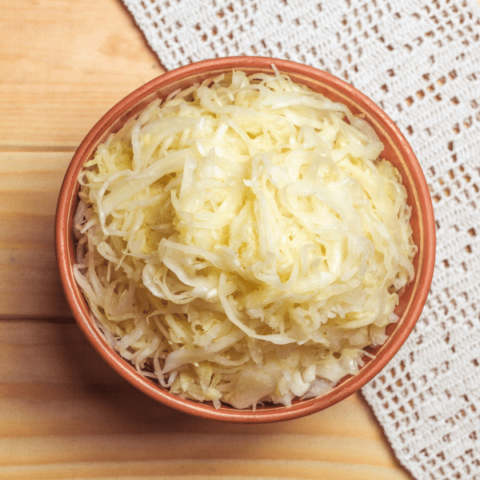Homemade sauerkraut is a great recipe to add to your gut healing protocol because it can help regulate the nervous system through blood sugar regulation, supporting a healthy gut microbiome, and helps regulate hormones.
Plus, it’s easy to make and tastes delicious.
What is sauerkraut and why is it good for your gut?
Sauerkraut is a type of fermented cabbage that has been around for centuries. During the fermentation process, bacteria break down the cabbage into a tangy and slightly sour food that is packed with probiotics.
Probiotics are live microorganisms that can help improve the balance of good and bad bacteria in your gut. When you eat sauerkraut, the probiotics help to improve your digestion and boost your immune system.
How does sauerkraut help regulate the nervous system?
Believe it or not, your gut and your nervous system are closely connected. Your gut has its own nervous system, called the enteric nervous system. This system communicates with your brain, sending signals that can affect your mood and stress levels.
When you eat fermented foods like sauerkraut, the probiotics can help to regulate the enteric nervous system, reducing feelings of anxiety and stress.
How does sauerkraut help regulate blood sugar levels?
Sauerkraut is also a good source of fiber. During the fermentation process, the fiber in the cabbage is broken down into short-chain fatty acids.
These acids can help to slow down the absorption of sugar in your bloodstream, reducing spikes in blood sugar levels. This can be helpful for anyone, but especially for those with conditions like diabetes or metabolic syndrome.

How to make homemade sauerkraut:
Making homemade sauerkraut is surprisingly easy, and you don’t need any special equipment. All you’ll need is:
- 1-2 heads of cabbage, thinly sliced
- 1 tablespoon of sea salt
- A clean, wide-mouthed jar
- A weight, like a small glass jar or a fermenting weight
Instructions:
- In a large bowl, mix the sliced cabbage and sea salt.
- Massage the cabbage with your hands for about 5 minutes until it starts to release water.
- Place the cabbage into your clean jar, pressing down firmly to remove any air pockets.
- Place your weight on top of the cabbage to keep it submerged in its own liquid.
- Cover the jar with a clean cloth or lid and let it sit at room temperature for about 5-7 days.
- After a week, taste the sauerkraut. If it’s tangy and slightly sour, it’s ready. If not, let it ferment for a few more days.
- Once it’s ready, transfer the sauerkraut to a sealed jar and store it in the fridge. It will keep for several months.
You can also try adding different spices or herbs to create different flavors. Some popular additions include caraway seeds, garlic, or ginger.
Cooking is all about experimenting to see what it is that you like best, so feel free to get creative and try new combinations! You may just come up with the next big flavor profile!

How to enjoy your homemade sauerkraut:
Homemade sauerkraut can be enjoyed in sandwiches, salads, or as a side dish to your favorite protein. Our favorite way to eat sauerkraut is heated up and put onto of pastrami with a tangy dressing!
Gut health is essential for nervous system regulation and your overall well-being, and homemade sauerkraut is an easy and delicious way to promote good health. With its probiotics, fiber content, and nerve and blood sugar regulating properties, sauerkraut is a great addition to any gut healing protocol.
Take a half hour for yourself and make a batch of homemade sauerkraut today!

Healing Homemade Sauerkraut
Homemade sauerkraut is a great recipe to add to your gut healing protocol because it can help regulate the nervous system through a healthy microbiome and blood sugar levels. Plus, it's easy to make and tastes delicious.
Ingredients
- 2 heads of cabbage
- 6 tbsp flakey sea salt or 3 tbsp coarse sea salt (avoid table salt)
- 2 tbsp grated ginger, turmeric or garlic
- Cabbage (can be all green or a mixture of red and green. If you choose red cabbage, you’ll end up with a pink sauerkraut, which can be quite fun and loaded with beta carotene, however it will taste the same.) Remove outer leaves and core.
- OPTIONAL: 2 cups coarsely grated or finely sliced carrot, beetroot, celery, red onion
- OPTIONAL: Caraway seeds, garlic, or ginger
Instructions
- Sterilize a large bowl or tub, your jars, your work surface and your hands.
- Finely slice the cabbage (we like to use a food processor or mandolin)
- Finely slice your additional vegetables, if using
- Place sliced cabbage and salt into the bowl or tub and massage for 10 minutes with clean hands. It should reduce in quantity considerably and produce a briney liquid.
- Add in your vegetables and spices, mix well.
- Using hands or tongs, stuff mixture into sterilized jars, ensuring the cabbage is covered with the liquid and there is approx 1-1.5cm space at the top of the jar.
- Store in a cupboard away from direct sunlight and 'burp' (open to remove the air and ensure cabbage is still under the surface of the liquid) every 24 hours. Use a sterilized spoon to push back under the liquid if it has risen
- Ferment for 5-14 days, it should be bubbling and active, but not moldy.
- Once happy with the flavor (will get more sour the longer you leave it) transfer to the fridge and store for up to 6 months.





